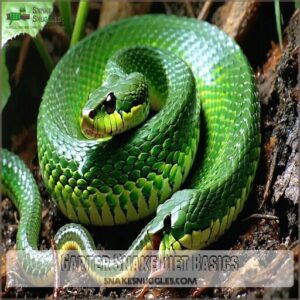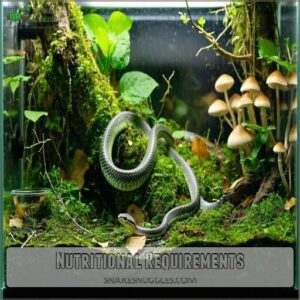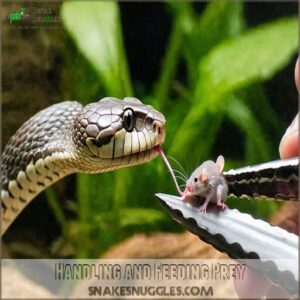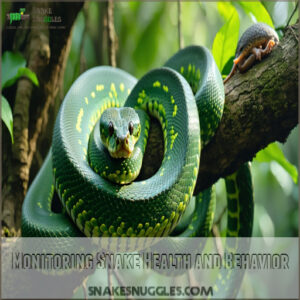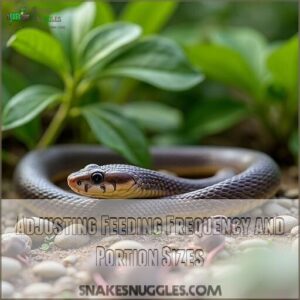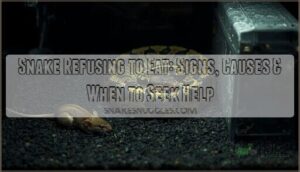This site is supported by our readers. We may earn a commission, at no cost to you, if you purchase through links.
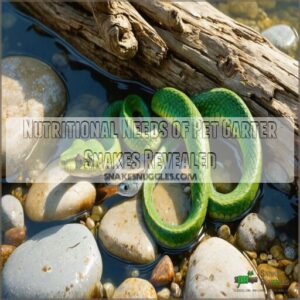 You’ll find meeting the nutritional needs of pet garter snakes isn’t rocket science.
You’ll find meeting the nutritional needs of pet garter snakes isn’t rocket science.
These slithery friends need protein-rich meals that match their size – think fish, worms, and appropriately sized rodents.
Feed babies every 4-5 days, juveniles weekly, and adults every 10 days.
Remember to dust food with calcium and vitamin D3 supplements for bone health.
Keep fresh water available and maintain humidity between 30-60%.
Your snake’s digestion works like a tiny furnace – proper temps are key!
Just like us, these reptiles thrive on variety, so mix up their menu.
Proper nutrition can make the difference between a snake that just survives and one that thrives.
Table Of Contents
- Key Takeaways
- Garter Snake Diet Basics
- Nutritional Requirements
- Food Selection Guidelines
- Environmental Factors
- Feeding Techniques and Tips
- Specialized Dietary Needs
- Frequently Asked Questions (FAQs)
- What should I feed my pet garter snake?
- What do garter snakes need in their tank?
- What is the most nutritious food for snakes?
- How long can garter snakes go without eating?
- Can garter snakes eat fish with thiaminase?
- Do brumating garter snakes need feeding?
- How to feed picky/reluctant garter snakes?
- Signs of nutritional deficiencies in garter snakes?
- Feeding pregnant or nursing garter snakes?
- Conclusion
Key Takeaways
- You’ll need to feed your garter snake protein-rich foods like mice, fish, and worms that match their size, with babies eating every 4-5 days, juveniles weekly, and adults every 10 days.
- You should supplement your snake’s diet with calcium and vitamin D3 powder to prevent deficiencies, especially if they’re primarily eating earthworms.
- You’ll want to maintain proper environmental conditions with temperatures between 75-85°F and humidity between 30-60% for optimal digestion and hydration.
- You can identify nutritional issues by watching for signs like shedding problems, scale issues, lethargy, or weight loss, and address them by varying your snake’s diet.
Garter Snake Diet Basics
You’re about to learn what your pet garter snake needs to eat, and it’s pretty simple: they’re carnivores, so they need a diet rich in meat.
As you set up your snake’s diet, you’ll want to focus on finding the right balance of prey size, type, and feeding frequency to keep them happy and healthy.
Carnivorous Lifestyle
You’re diving into the study of garter snakes, where meat consumption is key.
As a carnivore, your pet snake’s diet consists of prey capture, showcasing its hunting strategies.
Understanding their carnivorous nature is important for proper snake nutrition, meeting their nutritional needs through a balanced carnivore diet.
Prey Size and Type Selection
You’ll want to choose prey that’s just right for your pet garter snake.
Consider these options:
- Live food for snakes
- Frozen food for snakes
- Gutloaded prey
Prey size matters, so match it to your snake’s girth for a happy, healthy pet.
Feeding Frequency and Schedule
You manage feeding frequency by considering snake growth.
| Age | Meal Frequency | Nutrient Timing |
|---|---|---|
| Baby | every 4-5 days | morning |
| Juvenile | every 7 days | evening |
| Adult | every 10 days | flexible |
Adjust feeding cycles for effective garter snake diet.
Nutritional Requirements
You’re probably wondering what your pet garter snake needs to eat to stay healthy, and it’s great that you’re thinking about their nutritional requirements.
As you learn about their diet, you’ll find that they need a mix of protein sources, vitamins, and minerals, so it’s important to provide them with a balanced diet that meets their needs.
Protein Sources
You’ll need protein sources like fish, meat, and insects for your garter snake.
Maintaining proper snake nutrition is essential for their health.
Consider:
- Fish options
- Meat sources
- Insect alternatives, to provide a varied garter snake diet, focusing on rodent nutrition and prey variety, including frozen-thawed rodents.
Vitamin and Mineral Needs
You’ll want to supplement your pet garter snake’s diet with calcium and phosphorus for strong bones.
Vitamin D3 and vitamin supplements are also essential to prevent nutrient deficiency, ensuring a healthy balance and meeting their snake vitamin needs through dietary enrichment.
Frozen mice are a good food source, but a complete feeding guide offers more options for a balanced diet, including a variety of foods to meet the snake’s nutritional requirements, making it a valuable resource for dietary enrichment.
Hydration and Water Quality
You make sure your pet garter snake’s hydration needs are met by providing a clean water bowl, checking water purity, and maintaining proper humidity levels.
Consider the following key aspects of hydration for your pet:
- Fresh water daily
- Clean bowl
- Water bowl size
- Water accessory
Proper care also involves regularly checking and maintaining these elements to ensure the well-being of your pet garter snake.
Food Selection Guidelines
You’re now going to learn how to choose the right food for your pet garter snake, which is an important part of keeping them healthy.
By following some simple guidelines, like selecting a variety of prey and avoiding harmful foods, you can make sure your snake is getting the nutrients it needs to thrive.
Live Prey Vs Frozen Prey
You’re deciding between live prey and frozen prey for your garter snake.
Frozen prey is safer, easier to store, and reduces disease transmission risk, making it a great choice for snake nutrition and prey safety, considering your garter snake’s dietary choices and prey preferences.
Additionally, frozen thawed food minimizes the risk of injury to your pet, which is a key consideration for prey safety.
Prey Variety and Rotation
You’ll want to mix things up with prey variety and rotation, offering a range of foods to keep your snake engaged and stimulated, like a hunter in the wild.
To achieve nutrient balance and a balanced diet through prey diversity, it is essential to provide this variety.
You’ll be offering a range of foods to keep your snake engaged and stimulated, like a hunter in the wild, to achieve nutrient balance and a balanced diet through prey diversity.
Avoiding Harmful Foods
When feeding your pet garter snake, beware of toxic prey, bad foods, and harmful ingredients that can cause food poisoning.
Avoid unsafe feeding practices, including harmful fish, to keep your snake healthy and safe from unhealthy food and toxic foods, practice food avoidance to prevent harm.
Proper care includes a balanced snake diet plan to ensure your pet’s well-being and safety, emphasizing the importance of a balanced diet.
Environmental Factors
You’re about to learn how environmental factors, like temperature and humidity, affect your pet garter snake’s nutritional needs.
By understanding these factors, you can create a comfortable and healthy space for your snake to thrive, and that’s what we’ll explore in this section.
Temperature and Digestion Relationship
You’ll discover that temperature affects digestion rate in garter snakes.
Proper snake digestive health depends on many factors.
A thermal gradient is integral, as it influences metabolic speed and snake digestive health, preventing heat stress and supporting nutritional needs.
Temperature control is key to garter snake nutrition, so monitor it closely.
Humidity Impact on Hydration
Everyone knows proper hydration keeps your garter snake healthy, but humidity plays an important role too.
You’ll want to maintain humidity levels between 30-60% to support proper water intake and prevent dehydration.
Setting up a water bowl isn’t enough – moisture management through regular misting helps your snake stay hydrated.
Keep an eye on water quality and humidity control, especially during dry seasons.
Lighting and Vitamin D3 Synthesis
Just like your garter snake needs proper humidity, it also needs the right lighting setup.
While these slithery friends don’t require as much UVB as other reptiles, they’ll still benefit from proper UVB lighting to help with vitamin D3 synthesis and calcium absorption.
You’ll want to maintain a 12-hour photoperiod and create thermal gradients that let your snake regulate its exposure naturally.
Feeding Techniques and Tips
You’ll find that feeding your garter snake isn’t rocket science, but knowing the right techniques can make all the difference between a happy, healthy pet and a picky eater.
Whether you’re offering frozen mice or wriggling earthworms, you’ll need to master proper handling methods and portion sizes to keep your scaly friend thriving, which involves understanding complete concepts.
Handling and Feeding Prey
Smart snake owners know that proper prey handling keeps both you and your pet safe.
When it’s feeding time, use long feeding tongs to offer thawed prey, keeping your fingers away from those quick strikes. You can buy snake feeding tongs online.
Store frozen prey in sealed containers and thaw them in warm water just before feeding.
Never handle prey with bare hands – it’s a rookie mistake that could lead to accidental bites.
Monitoring Snake Health and Behavior
Keeping a watchful eye on your garter snake’s health is like being a snake detective – small clues tell big stories.
Regular health checks help you spot potential issues before they become serious problems.
Here are key signs to monitor:
- Track your snake’s weight monthly – sudden changes can signal health concerns
- Watch eating patterns and appetite levels for metabolic changes
- Notice behavioral shifts that might indicate stress or nutritional deficiencies
Monitoring these signs is crucial for maintaining your garter snake’s overall health, as it allows for early intervention and prevention of serious issues.
Adjusting Feeding Frequency and Portion Sizes
Your garter snake’s appetite changes like the seasons, so you’ll need to adjust feeding frequency and portion sizes accordingly.
Young snakes thrive on smaller meals every 4-5 days, while adults do well with weekly feedings.
Watch your snake’s body condition – a healthy snake should be round but not bulging. If you’re seeing signs of weight gain, space out meals or reduce portions to maintain a healthy snake and prevent weight gain.
Specialized Dietary Needs
You’ll need to tweak your pet garter snake’s diet based on its species, age, and activity level, just like how you’d adjust your own meals if you were training for a marathon.
While these slithery friends don’t need protein shakes or vitamin pills, they’ll thrive on a mix of properly sized prey and occasional supplements to match their unique nutritional needs, ensuring they receive the right amount of nutrients for optimal health, with supplements added as necessary.
Dietary Considerations for Species and Age
Now that you’ve mastered feeding techniques, let’s match your snake’s diet to their unique needs.
Different garter snake species have varying appetites and preferences – what works for a Common Garter mightn’t suit a Ribbon Snake.
Understanding a snake species’ diet is essential for their health and requires careful consideration of their specific needs.
Young snakes need protein-rich meals every 4-7 days, while adults can go 7-14 days between feedings.
Watch your snake’s body condition to fine-tune their meal plan.
Supplements for Garter Snakes
After adjusting diet for your snake’s age, you’ll want to think about vitamin boosters.
You can find suitable calcium supplements online.
Your slithery friend needs calcium supplements, especially with earthworm-based diets.
Just dust prey items lightly with calcium powder containing vitamin D3 once or twice monthly.
Think of these mineral supplements as a snake’s multivitamin!
Liquid calcium options work too.
Without proper calcium, your snake could develop a wobbly walk – a telltale sign of calcium deficiency .
Managing Stress and Promoting Healthy Appetite
While supplements help with nutrition gaps, your garter snake’s stress directly impacts their appetite. A relaxed snake eats better!
- Place the feeding area away from high-traffic spots to reduce snake anxiety during meals
- Try feeding at dusk when garter snakes naturally hunt
- Add natural enrichment items like rocks or branches that make your snake feel secure
Remember, stress reduction leads to better feeding habits and improved health, which is crucial for a relaxed snake that eats better.
Frequently Asked Questions (FAQs)
What should I feed my pet garter snake?
Feed your snake frozen/thawed mice weekly, with occasional earthworms or feeder fish. Avoid goldfish, insects, and human foods. Babies need smaller prey every 4-5 days. Always provide fresh water.
What do garter snakes need in their tank?
As snug as a bug, your garter snake needs a secure 20-gallon tank.
With this tank, it is essential to include hiding spots, climbing branches, proper substrate like aspen shavings, a water dish, and heating to maintain 75-85°F temperatures.
What is the most nutritious food for snakes?
Your garter snake will thrive on a varied diet.
Mice offer complete nutrition, while earthworms and feeder fish (occasional treats) provide good supplements.
Always verify prey size matches your snake’s girth.
How long can garter snakes go without eating?
Your snake can survive 1-2 months without food, but they shouldn’t go longer than 2-3 weeks. Young garters need meals more often, while adults can handle longer intervals between feedings.
Can garter snakes eat fish with thiaminase?
To swim in dangerous waters is unwise.
You shouldn’t feed your garter snake fish containing thiaminase, as it breaks down vitamin B1 in their bodies, potentially causing serious health issues or death.
Do brumating garter snakes need feeding?
During brumation, your garter snake’s metabolism slows dramatically, and they don’t need feeding.
Attempting to feed them during this winter rest period can cause dangerous health issues as they can’t properly digest food.
How to feed picky/reluctant garter snakes?
Like coaxing a shy butterfly, entice reluctant garter snakes by warming prey, using tongs for movement, trying different food types, and feeding at dusk.
Be patient and offer privacy during mealtimes.
Signs of nutritional deficiencies in garter snakes?
Watch for shed problems, scale issues, lethargy, weight loss, and bone deformities. You’ll notice these warning signs when your snake isn’t getting proper nutrients. Provide varied prey to avoid deficiencies.
Feeding pregnant or nursing garter snakes?
Pregnant garter snakes need more frequent feeding (every 4-5 days) and larger portions.
You’ll want to offer high-protein foods like pinky mice or fish.
Keep fresh water available at all times.
Conclusion
Picture your garter snake thriving like a well-oiled machine when you meet its nutritional needs properly.
You’ll see your slithery friend’s colors brighten and activity levels increase with the right diet mix.
Remember, varied protein sources, proper supplements, and consistent feeding schedules aren’t just recommendations—they’re essentials.
By balancing the nutritional needs of pet garter snakes with environmental factors, you’re not just keeping a pet alive—you’re helping it flourish.
Isn’t that what every snake parent wants?
- https://pangovet.com/pet-nutrition/snakes/what-do-garter-snakes-eat/
- https://allanspetcenter.com/how-to-care-for-your-garter-snake/
- https://www.petmd.com/reptile/garter-snake-care-sheet
- https://reptileshowsofnewengland.com/the-garter-snake-diet-what-you-need-to-know/
- https://www.reptilecentre.com/pages/info-garter-snake-care-sheet

